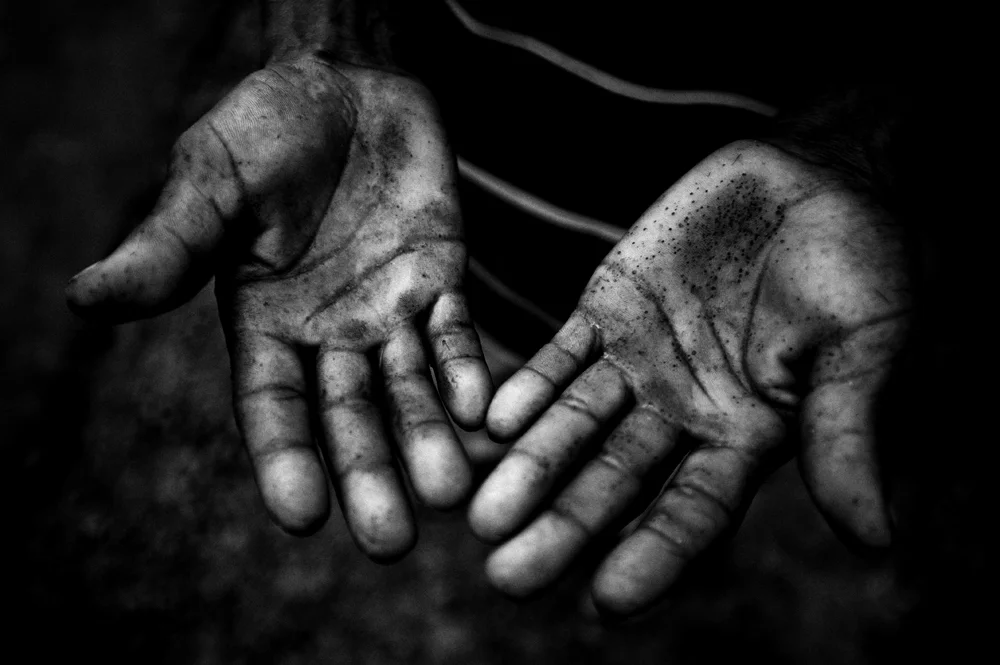Consequences
by NOOR
© Yuri Kozyrev / NOOR
From the frontiers of climate change comes Consequences by NOOR, featuring the work of nine internationally acclaimed photographers who documented the devastating effects of climate change around the globe.
The project intended to show the humanitarian consequences of climate change; focusing on actual facts that had devastating effects on the lives of millions of people around the world: floods, drought, hunger, disease, animal extinction, conflicts, migration and loss of human rights. Their stories were gathered in the multimedia project "Consequences by NOOR", realized with the support of Nikon Europe BV and funds from a large group of international organizations. From concept to dissemination, NOOR took the project to its widest possible audience.
Collectively, the participating NOOR photographers visited the hunger victims in the deserts of Darfur, the flood victims of Bangladesh, the survivors of Hurricane Katrina, and traveled to the Maldives, Poland and Brazil, amongst other places, to witness the issues at stake. In combination with their encompassing archival work, their stories document the biggest challenges our world faced at the time.
"Consequences by NOOR" premiered at the United Nations Climate Change Conference in Copenhagen, in December 2009, catching the attention of thousands of international delegates, scientists, journalists and activists.
Blackfields: Poland’s Coal Industry
by Pep Bonet
Poland is the second largest coal producer and consumer in all of Europe and consequently one of the most polluted and polluting countries.
From all fossil fuels, brown coal is the one that has the biggest impact on climate change, producing 1/3 of the worlds CO2 emissions. Pep Bonet visited the region of Upper Silesia - one of the most heavily industrialised and polluted areas in the continent - to document the environmental and humanitarian impact of coal mining.
During his trip to Poland Pep visited “Adamow”, a coal mine that pumps 80 to 120 million-m3 of water out of the ground every year. Dry grounds enable the extraction of brown coal but the lack of water makes the land infertile affecting the life of local inhabitants.
Pep: “the surrounding burnt-out landscape is littered with heaps of coal waste, trucks and excavators. Deep in the mine, conveyor belts slither along, laden with earth and rock. On the observation deck built around the hole, people fall silent; the view has a sobering effect”.
Poland has one of the highest numbers of lakes in the world and the current developments of expanding mining throughout the country will have a serious impact on these natural resources. Devastating effects can occur on the fragile ecosystem endangering several species. Marshes and peat bogs can also dry up, causing irreversible destruction.
Researchers believe that the impact of these new mining operations will affect not only surrounding areas but also regions hundreds of kilometers away. If mining companies continue to refuse considering these facts and reevaluate their plans, the damage caused by opencast mining in Poland might have only just begun.
Based on a story by Marta Kazmierska | Greenpeace
Shadows of Change
by Stanley greene
Greenland's ice caps are melting at an alarming rate, raising global sea levels and threatening the local way of life. Nowhere on Earth, perhaps, is the evidence of climate change more apparent. The ice that covers 80 percent of the world's largest island is disappearing at the rate of 7 percent a year, a rate that has accelerated substantially in recent years.
In some places, the ice shelf is already too thin to permit the Inuit to travel to traditional hunting grounds. The permafrost is also melting, producing a land that is boggy, unstable for buildings and difficult to cross by the traditional sleds. Worst-case scenarios predict that the carbon released by the melting permafrost could equal all the carbon already in the Earth's atmosphere.
The Inuit, who survived for centuries by hunting seals and whales, are watching their way of life disappear before their very eyes. "This weather does not belong to us. It belongs to someone else. If we don't have ice, we are going to die." With this prediction, an Inuit hunter sums up the dire situation for the indigenous peoples who live in northern and eastern Greenland.
Yamal Peninsula
by Yuri kozyrev
Yamal Peninsula: home to the Nenet population and the largest natural gas reserve in the world.
In the language of the indigenous Nenet, "Yamal" means "world's end." This more than 700 kilometre long peninsula in North Western Siberia, Russia, is home to more than 40.000 Nenet and the largest natural gas reserve in the world. For a thousand years, the Nenet have herded their domesticated reindeer to summer pastures above the Arctic Circle.
The Nenet's traditional way of life is threatened by warming temperatures and by the world's rapacious appetite for natural gas. Traditionally, the Nenet travel across the frozen Ob River in November and set up camp in the forests. These days, this annual winter pilgrimage is delayed. The Nenet, together with many thousands of reindeer, have to wait until late December when the ice is finally thick enough to cross. And with the gas wells have come railroad tracks and natural gas pipelines that bisect herding routes and cause reindeers to break legs. Fish, once an abundant dietary staple, have also diminished: the Nenet blame offshore drilling.
Paradise in Peril
by Francesco Zizola
The Maldives, the lowest lying nation on earth, is at risk of disappearing from the world map, scientists say. Global warming and the melting of polar ice caps are causing sea levels to rise at a rate of about 2 mm (0,8 in) per year, endangering the survival of the small island nation, whose average height above mean sea level is a mere 1 meter (3,3 ft).
Ever since he came to power at the end of 2008, president Mohamed Nasheed - the first head of State to be democratically elected in the history of the Maldives -, has shown the world his intention to seriously address the problem and enhance sustainable environmental policies.
After attracting the world’s attention with his intention of buying a new homeland for his people, Mr. Nasheed strived to hold the richest countries to their responsibilities through a forcefull and dynamic media campaign. Though the Maldives are hardly accountable for any consistent contribution to global warming, it is one of the countries that will be most dramatically affected by climate change. In Mr. Nasheed’s opinion the Maldives need to lead the way towards a sustainable future. This is why, without waiting for the outcome of the Copenhagen summit, he recently announced Maldive’s intention of becoming carbon neutral by 2020.
The photographic series we are presenting aim to show the signs of the threats Maldives are faced with in a near future by surveying the state of the country’s environment in the lead up to an announced revolution in environmental policy. The road ahead is a difficult one from every angle. Far from being a zero carbon emission producing country, the Maldives has a highly polluting power generating system based on diesel power plants. Malé powerhouse alone requires over 115,000 liters of diesel daily for operation. Plans for the use of renewable energy sources in the production of electricity are not in practice yet and the transportation system, for both goods and people, relies on fossil fuels only.
The absence of an effective waste management system is a problem that torments the country. The Maldives currently lacks the facilities to separate, collect and recycle materials generated by households and businesses.Unsorted solid waste is dumped in landfills such as Thilafushi, the so-called ‘rubbish island’, where it’s incinerated or buried. Waste materials such as crushed cans, metals and cardboard are shipped to India.
As the photographs show, there is a strong link between tourism, the principal source of income for the Maldives, and pollution. In 2008, 683 thousand people visited the Maldives. It has been estimated that each tourist at a resort generates 4.6 kg of waste a day, adding to the rubbish daily generated by 396,334 Maldivians (Malé inhabitants: 1.1kg/2.4lb; Atolls inhabitants: 0.7kg/1.5lb). In the absence an adequate waste collecting program, tourists and locals often dump their rubbish on the beach or into the sea.
A tropical paradise of crystal clear waters and white sand beaches in the imagination of many who choose it as a favorite destination for honeymoon travels and dream holidays, the Maldives has also a dark side that has been kept hidden from tourists. The strong contradictions the country is suffering from are shedding a gloomy light on the future of its survival.
In The Oil Sands
by Jon Lowenstein
The oil sands of Alberta, Canada, one of the world's second largest reserve of crude oil and a major source of greenhouse gases.
The oil sands of Alberta, Canada, represent the second largest source of crude oil in the world, behind Saudi Arabia. Unlike conventional crude oil, which is pumped from deep within the earth, oil sands are a mixture of sand, clay, water and bitumen, found near the surface. Oil sand mining degrades the landscape, pollutes the water and with its associated refining industries accounts for five percent of Canada's total greenhouse gas emissions.
In our interconnected global world, the story of these oil sands is as much about polluted water as it is about polluted dreams: it exposes the degraded terrain of the mining site while it reveals the decayed terrain of human avarice. Mining and refining the oil sands is an expensive process, but with the rise in the price of oil, it has become very profitable. The small town of Fort McMurray, where many people live that work in the oil sands, is known to its residents as Fort McMoney. The town has exploded with the influx of oil patch workers from around the globe, and Canada's coffers have swelled with billions in royalties.
Brazil's Range War
Brazil’s Range War: Assault on the Amazon
by Kadir van Lohuizen
Cattle ranching in the Amazon is a major driver of deforestation and contributor to increased greenhouse gas emissions.
The rainforests of the Brazilian Amazon, the most biologically diverse place on Earth, are shrinking by tens of thousands of square kilometres a year. About 60 to 70 percent of that deforestation occurs as ranchers cut, burn and bulldoze trees, to create pastures for the country's burgeoning cattle industry. In recent years, Brazil has become the largest exporter of beef and, not coincidentally, the third largest polluter in the world, after China and the United States. Every eight seconds the size of a football field disappears in the Brazilian Amazon.
Fires from the burning forests and the ovens that heat the wood into charcoal fill the skies. The cattle, too, are responsible for methane gases. Methane has a global warming potential more than twenty times greater than that of carbon dioxide. Most of the deforestation for pastures is illegal, however the cattle farmers are a powerful force in Brazil where 75 percent of the land is owned by three percent of the people. Even nature preserves, such as Terra do Meio, are not safe from the illegal deforestation.























